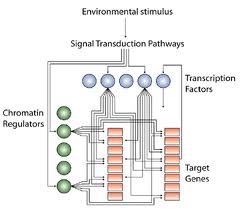Yes, blocking of a few master genetic switches associated with “super enhancers” might be a simple cure for cancer, says Dr. Richard Young, of Whitehead research institute, MA, senior author in two papers in the prestigious, peer – reviewed paper, Cell, and founder of a start-up company, Syros Pharmaceuticals, with the goal to cure cancer. The company has raised 30 million dollars to support its goal to cure cancer by finding and switching off the master switches in each type of cancer. You may click here to read the Cell paper led by Dr. Jakob Loven, for “Selective inhibition of tumor oncogenes by disruption of super enhancers”, and here to read the Cell paper led by Dr. Warren A. Whyte, for “Master transcription factors and mediator establish super enhancers at key cell identity genes. Both the papers have a single, master illustration explaining the main concept. It is must see to understand how simple the hypothesized solution is. 
Dr Young’s team says a normal cell regulation is remarkably less complex, with core genes controlled by only a few hundred super enhancers. With this hypothesis, cancer research focus is forever changed since April 2013, and gives remarkable insight to how a single fertilized egg from a father and mother can develop into a unique individual, with two-thirds of his/her diseases having a genetic determination. Loss of old super enhancers and assembling a cluster of new enhancers drives cell identity as a human grows develops.
For years cancer scientists have been reporting their discoveries of the mediators responsible for over expression of cancer genes. What makes Dr Young’s work more unique is that it suggests that a few master switches might control this gene at super enhancer regions. There are thousands of cancer gene transcription factors in the literature. One example is the study of pancreatic cancer, the fourth commenest cause of cancer related deaths in the western hemisphere. Several key genes have been shown to play a role in pancreatic cancer, including the oncogene K-RAS and several tumor suppresor genes including some from the TGF signalling pathway. The researchers discovered that the Fibroblast growth factor receptor gene 4 (FGFR4) was overexpressed in almost two-thirds of pancreatic cancers. They found a research outside this gene called intron 1, was greatly extended in pancreatic cancer cells. Two sites binding transcripton factors and two sites binding mediators were identified, and additionally, the team discovered which mediator was essential for over expression of FGFR4 to cause pancreatic cancer. You may read about this pancreatic cancer work led by Dr. Helen C Hurst of London by clicking here. Might this deadly pancreatic cancer too be controlled by inhibiting one or more of the several hundred master switches?
signalling pathway. The researchers discovered that the Fibroblast growth factor receptor gene 4 (FGFR4) was overexpressed in almost two-thirds of pancreatic cancers. They found a research outside this gene called intron 1, was greatly extended in pancreatic cancer cells. Two sites binding transcripton factors and two sites binding mediators were identified, and additionally, the team discovered which mediator was essential for over expression of FGFR4 to cause pancreatic cancer. You may read about this pancreatic cancer work led by Dr. Helen C Hurst of London by clicking here. Might this deadly pancreatic cancer too be controlled by inhibiting one or more of the several hundred master switches?
Do you prefer a non scientific explanation of the above solution? A very simple explanation of the complex work done by Dr. Richard Young and his team of enthusiastic young scientists is given by Amy Maxmen in the respected weekly journal, Nature and you might read it by clicking here. She appropriately titles it “Super-powered switches may decide cell fate”. Different cells in the body have the same genes swithced on at different times. When such cells are switched on by a super enhancer complex due to unknown factors (as yet), then the cell becomes cancerous. You might say that cancer cells are “fueled” by “super enhancers”, and might suggest inhibiting such a fueling source to cure cancer and you might be correct to be hopeful, albeit with a heavy dose of patience. Last year it was discovered there are a million enhancers in the human genome. Dr Young speculates that some of these enhancers act together in large clusters and function as a unit. How are cancer cells able to employ such super enhancers to produce more of their harmful factors that lead to aggressive tumors? 
Dr. Richard Young and his team of enthusiastic young scientists deserve to know if you support their goal. Do write to them if you do to encourage them. Scientists work long hours tied to a laboratory bench. Although they love their job to solve mighty goals, receiving your notes of encouragement will inspire them further. Do keep in mind that discovery through clinical trials with FDA approval to doctors office may take a decade or longer and might cost a billion dollars for each drug in research over that period. So 30 million dollars will not take them too far without your support and creative solutions to funding.
Email: Dr Richard A. Young and his team at young@wi.mit.edu
Snail mail: Whitehead Institute for Biomedical Research, 9 Cambridge Center, Cambridge, MA 02142, USA


